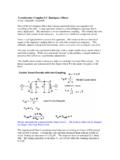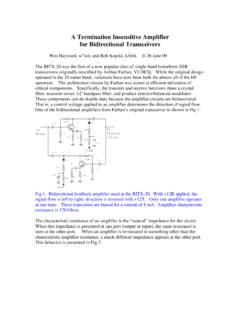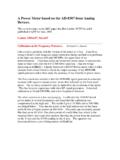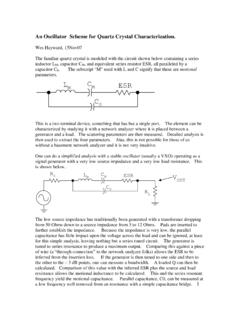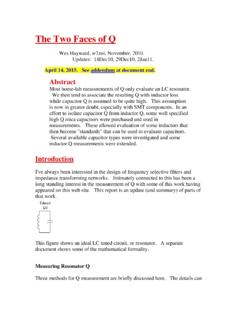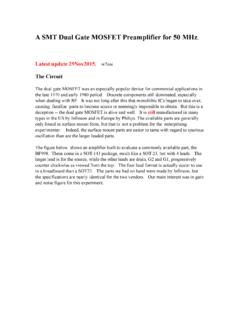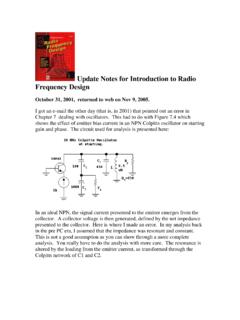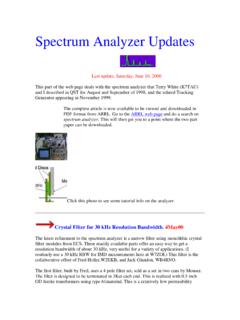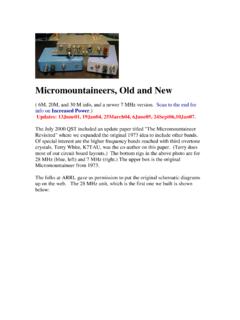Transcription of Abstract for Experimental Methods in RF Design - …
1 Abstract forExperimental Methods in RF DesignbyWes Hayward, W7 ZOI; Rick Campbell, KK7B; and BobLarkin, W7 PUAP ublished by ARRL, 2003512 pages with approximately 1000 figures and a CD ROM Experimenting for the radio amateur is that activity that occurs when a newidea is committed to usually includes building or homebrewing some circuitry, but that is only part of the alsoincludes the planning, analysis, measurement, evaluation and packaging thataccompanies the art of this collected activity is what we 1, Getting Experimentation, Homebrewing, and the Pursuit of the New:This is abrief philosophical comment regardingour views on the subject at Getting Started Routes for the Beginning Experimenter:We begin witha discussion of construction Methods , which emphasize breadboarding, or one-of-a-kind Some Guidelines for the Experimenter:A collection of hints and pitfallsrelated to success in experimenting is presented, observations that we have(sometimes painfully) Block Diagrams:This section briefly describes the block diagrams usedthrough the book for the systems we An IC Based Direct Conversion Receiver.
2 This simple receiver is awonderful first project, offering good performance on any of several A Regenerative Receiver:Many readers will certainly ask why wouldanyone ever build a regen receiver in this modern are manyanswers, but the strongest is that the mere act of using such equipment is anexperimental philosophy of adapting the Design to fitavailable parts is in keeping with the rest of the An Audio Amplifier with Discrete Transistors:This is a simple designthat folks can build to drive a small speaker when they don t have an audio A Direct Conversion Receiver Using a Discrete Component ProductDetector:Thisdesign shows a simple DC receiver using a differentialamplifier as the local oscillator is varactor diode tuned and themodel shown uses surface mount technology (SMT.)
3 Power Supplies:This section address the need of powering theeq uipment and test equipment used by the beginning supply designs are offered that use readily available RF Power Measurements:We will shortly be presenting a transmitter,so we need a way to measure radio frequency meters using atermination and a diode peak detector are dual designs aresuggested, allowing measurement over a wider RF probe is alsopresented that can be used with a traditional VTVM or FET A First Transmitter:This section follows the Design of a simpletransmitter, here operating on the 40 meter Design starts with acrystal building and testing this, we add a buffer output of this stage is studied and a 200 milliwatt outputamplifier is added to realize a low power transmitter that is still suitable for useon the A Bipolar Transistor Power Amplifier:A simple brick is built tobring the output up toa much more practical level of 2 inexpensivetransistor is An Output Low Pass Filter.
4 The transmitter just described may not beuseable on the air owing to excessive harmonic , we built a filterthat can be added at the filter is built as an isolated module so itcan be used with other section concludes the transmitter byadding shaped keying, transmit/receive switching, a power output control, asidetone oscillator, a spot switch, and some tuning in the oscillator to achievesome VXO transmitter has been used with the IC Based DirectConversion Receiver described above for contacts on the 40 meter About the Schematics in this Book:We have made a few departuresfrom standard ARRL the most significant one is that we tryto put a lot of data directly into the drawing, including coil data when allows us to bypass the parts lists otherwise 2,Amplifier Design BasicsThis chapter is the first in four aimed at the study of fundamental circuit types,with this chapter devoted to follows the format of Solid StateDesign for the Radio Amateur, SSD, where modeling and amplifier basicdesign ideas were integrated with some practical Modeling Simple Solid State Devices.
5 The chapter begins with somebasic ideas of modeling, illustrated by the junction diode ismodeled as a perfect diode in series with a battery and morecomplicated mathematical expression is then small-signal model iscontrasted with the large signal diode behavior is then extended togenerate a bipolar transistor, modeled as a combination of diodes and adependent current signal models are derived for large signal model is now applied, used to analyze methodsfor biasing the discussions are presented for the junction fieldeffect Amplifier DesignBasics:Amplifiers are now studied with use the models to calculate voltage gain for some simple and output resistance are also discussion is extended toFETs and to some high frequency Large Signal Amplifiers:The basic models used for biasing can also beused for analysis of circuits with large or practical (real) signal the levels we might find well into a receiver system, or in a distortions are studied, illustrated with a simple emitter power amplifier is then Gain, Power, dB, and Impedance Matching.
6 These parameters are alldefined, definitions needed throughout the reflection Differential Amplifiers and the Op-Amp:A special circuit type ispresented, the differential ideal diff-amp is the op-amp, a formnow basic rules for application are Undesired Amplifier Characteristics:Some undesired characteristics ofany small signal amplifier are include noise, gaincompression, harmonic distortion, and intercept idea Feedback Amplifiers:We now present one of our favorite circuits, thesingle transistor feedback is presented with designequations that allow the experimenter to Design his or her own advanced forms are Design information program on the book CD, , also considers that analysis, a more refined (hybrid-pi) model is used for thebipolar Bypassing and Decoupling.
7 This section discusses the critical, and oftenneglected problems of bypassing and differences between thetwo are problems with most bypass capacitors is modeled bya small inductor in series the larger problems of paralleledbypass capacitors are Power Amplifier Basics:The next section deals with RF poweramplifiers, beginning with a discussion of amplifier operation Practical Power Amplifiers:Several practical amplifier types arepresented, augmented by example information is expanded frombipolar transistors to include power MOSFET types, again with practicalexamples for both CW and SSB technique is efficiency considerations are A 30-W, 7-MHz Power Amplifier:The chapter is finished with apractical example, an amplifier capable of over 30 watts output at 7 MHz orhigher from a $1 3, Filters and ImpedanceMatching Filter Basics:This chapter begins with some The Low-Pass Filter Design and Extension.
8 A discussion of low are basic to all other filter types, but are important in equations are given for some Butterworth and Chebyshev low passfilters,and are illustrated with variety of transformations areconsidered, allowing a low pass Design to be converted into a high pass, abandpass, and even a band stop that the numeric details here aresimplified for the reader byone of the included Windows software programs, LC Bandpass Filters:This section introduces the idea of Q and deals withLC bandpass filters as coupled resonators or emphasis is on thedesign of double and triple tunedcircuits with practical, Q simplify double and tripletuned bandpass filters designs.
9 Higher order designs are possible with the Crystal Filters:The next section deals with quartz crystals, theirevaluation and modeling, and their application as bandpass are presented for practical measurements as well as simple is expanded to the Design of more complicated crystal shape is discussed with regard to section of thechapter is augmented by Windows programs , which expedite the crystal filter Design Active Filters:RC active filters appear in the next are given for several simple all pass filter (phase shiftingnetwork)is briefly discussed and applied to an unusual analog filter type, aFIR filter, usually only considered possible with digital signal Impedance Matching Networks.
10 This section begins with a discussion ofthe directional nature of impedance in a classic L, pi, and Teenetworks are discussed with included Design linesthen provide impedance matching, followed by ideal transformers using poweriron and ferrite ferrite loaded transmission line transformer ispresented, including some popular forms using multiple sectionthen moves to the discussion of networks with more than just two include the splitter/combiner, diplexers, directional couplers, andquadrature 4, Oscillators and FrequencySynthesisThe vital function of generating a signal for use in transmitters andreceivers isthe basis for this LC Oscillator Basics:The chapter begins with descriptions of anoscillator circuit as an amplifier combined with a single tuned thenask the question: Will it oscillate?
